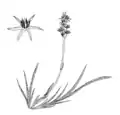Narthecium ossifragum
Narthecium ossifragum, commonly known as bog asphodel,[1] Lancashire asphodel or bastard asphodel,[2] is a species of flowering plant in the family Nartheciaceae. It is native to Western Europe, found on wet, boggy moorlands up to about 1,000 m (3,300 ft) in elevation. It produces spikes of bright yellow flowers in summer. The bright orange fruits have been used as a colourant to replace saffron by Shetland Islanders.[3] Despite the plant's English name "bog asphodel", it is not particularly closely related to the true asphodels. In addition to other forms of pollination, this plant is adapted to rain-pollination.[4] The Latin specific name ossifragum means "bone-breaker", and refers to a traditional belief that eating the plant caused sheep to develop brittle bones. The probable origin of this story is that sheep eating a calcium-poor diet are likely to develop bone weakness, and N. ossifragum favours acidic low-calcium soils.[3]
| Narthecium ossifragum | |
|---|---|
.jpg.webp) | |
| Scientific classification | |
| Kingdom: | Plantae |
| Clade: | Tracheophytes |
| Clade: | Angiosperms |
| Clade: | Monocots |
| Order: | Dioscoreales |
| Family: | Nartheciaceae |
| Genus: | Narthecium |
| Species: | N. ossifragum |
| Binomial name | |
| Narthecium ossifragum | |
Description
Bog asphodel is a tufted, hairless herbaceous perennial with a creeping rhizome. The leaves are up to 6 in (15 cm) long, narrow, flattened and sword-shaped, and often tinged with orange. The inflorescence is a spike with bright yellow, star-like flowers about 0.7 in (18 mm) across, which have short white hairs on the orange stamens. The fruits are deep orange.[5][6]
Biology
The plant can cause photosensitisation, a serious skin condition of sheep called alveld, "elf fire", in Norway. It can be relieved by moving stock into the shade. Not all stands of the plant are toxic, and the toxicity may be the side effect of the plant's response to a fungal infection.[7][8][9]
Distribution and habitat
The Bog asphodel has a temperate oceanic distribution in northern and western Europe. In the British Isles it occurs in Scotland, Northwest England, Wales, Southwest England and most of Ireland. It grows in wet soils and peats, in bogs, wet heaths and flushes.[10] It can be found in purple moor grass and rush pastures.[2]
Gallery
.jpg.webp)

 Fruiting
Fruiting In fruit
In fruit In situ near El Serrat, Andorra
In situ near El Serrat, Andorra.JPG.webp) High Fens, Belgium
High Fens, Belgium Illustration in Jakob Sturm: "Deutschlands Flora in Abbildungen", Stuttgart (1796)
Illustration in Jakob Sturm: "Deutschlands Flora in Abbildungen", Stuttgart (1796) Drawing by Elly Waterman
Drawing by Elly Waterman
References
- BSBI List 2007 (xls). Botanical Society of Britain and Ireland. Archived from the original (xls) on 2015-06-26. Retrieved 2014-10-17.
- "Pacific Bulb Society | Narthecium". pacificbulbsociety.org. Retrieved 2017-02-23.
- Richard Mabey Flora Britannica
- Hagerup, O. 1950. Rain-pollination. I kommission hos E. Munksgaard. Retrieved 26 May 2018.
- McClintock, David; Fitter, R.S.R. (1961). The Pocket Guide to Wild Flowers. London: Collins. p. 201.
- Sterry, Paul (2006). Complete British wild flowers. London: Collins. ISBN 978-0-00-720469-4.
- Handbook of Plant and Fungal Toxicants by J. P. Felix D'Mello
- George B. B. Mitchell, 'Non-parasitic skin diseases of sheep' In Pract., Vol. 10, Issue 2, 69-73, March 1, 1988
- Arne Flåøyen, 'Studies on the aetiology and pathology of alveld'
- "Narthecium ossifragum". Online Atlas of the British and Irish Flora. Retrieved 12 March 2020.